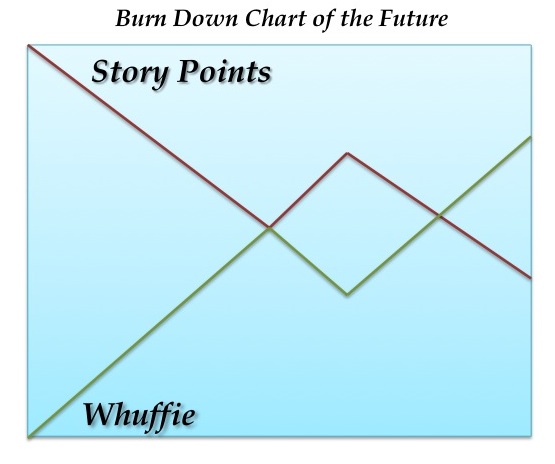
Virtual currency like Cory Doctorow’s concept of Whuffie will probably replace real money in the next 100 years. Maybe sooner with the way our current economic crisis is going. Once all the hard currency in the world is spent it’s Gresham’s law FTW!
You can get a head start by using Agile development principles to min-max your Whuffie earning potential.
Cory shows us how in his seminal book Down and Out in the Magic Kingdom. (Released under a creative commons license.)
I’m not sure if Cory meant to illustrate the principles or Agile development or he just stumbled into them. Since principles are laws of nature that exist independently of people I like to think that Cory was just observing how collaborative projects tend to take longer than expected or turn into epic failures. Some truths are self-evident as the founding fathers liked to say.
In Down and Out the protagonists are trying to quickly refurbish Disney’s Haunted Mansion with cool new robotic effects. They ask the head Imagineer (Still the coolest job title in the world!) how long it will take:
“Okay, so tell me, if we came to you with this plan and asked you to pull together a production schedule — one that didn’t have any review, just take the idea and run with it — and then pull it off, how long would it take you to execute it?”
Lil smiled primly. She’d dealt with Imagineering before.
“About five years,” he said, almost instantly.
Our heroes don’t have five years. A rival team is updating the Hall of Presidents with leet virtual reality spam in just a matter of weeks. So our plucky protagonists demand an explanation:
“Five years?” I squawked. “Why five years? Debra’s people overhauled the Hall in a month!”
“Oh, wait,” he said. “No review at all?”
“No review. Just come up with the best way you can to do this, and do it. And we can provide you with unlimited, skilled labor, three shifts around the clock.”
He rolled his eyes back and ticked off days on his fingers while muttering under his breath. He was a tall, thin man with a shock of curly dark hair that he smoothed unconsciously with surprisingly stubby fingers while he thought.
“About eight weeks,” he said. “Barring accidents, assuming off-the-shelf parts, unlimited labor, capable management, material availability. . .” He trailed off again, and his short fingers waggled as he pulled up a HUD and started making a list.
Five years? Eight weeks? Our heroes are perplexed. It seems outside the realm of sanity that a project could take either Five years or eight weeks. (But not if you think about Windows Vista or Apple’s System 7.)
“Wait,” Lil said, alarmed. “How do you get from five years to eight weeks?”
Now it was my turn to smirk. I’d seen how Imagineering worked when they were on their own, building prototypes and conceptual mockups — I knew that the real bottleneck was the constant review and revisions, the ever-fluctuating groupmind consensus of the ad-hoc that commissioned their work.
Suneep looked sheepish. “Well, if all I have to do is satisfy myself that my plans are good and my buildings won’t fall down, I can make it happen very fast. Of course, my plans aren’t perfect. Sometimes, I’ll be halfway through a project when someone suggests a new flourish or approach that makes the whole thing immeasurably better. Then it’s back to the drawing board. . . So I stay at the drawing board for a long time at the start, get feedback from other Imagineers, from the ad-hocs, from focus groups and the Net. Then we do reviews at every stage of construction, check to see if anyone has had a great idea we haven’t thought of and incorporate it, sometimes rolling back the work.
It’s interruptions that add months and even years to a schedule. Corry is not making this stuff up.
An Agile process like SCRUM recognizes this fact and uses the concept of the sprint to create a bubble of focus in an ocean of distractions. During a sprint nothing should change-if something does change (new business reality, a framework that doesn’t work as advertised) the sprint is broken. Sprints are kept short so that change can be accommodated in efficient chunks. Corry is simply pointing out why sprints lead to faster development cycles than non-Agile processes.
A few things are interesting to note:
- The 12 principles of the Agile Manifesto don’t talk about sprints. The principle of time-boxing a problem seems to be missing. SCRUM and other Agile methods inspired by automotive process management married the idea of sprints or locked iterations to Agile.
- In Corry’s book the Imagineers fall weeks behind schedule because they can’t handle their newfound freedom from stakeholder feedback. I’m pretty sure it’s because our heroes are too busy struggling through their own character driven plot to act as product owners and keep the Imagineers focused.
- There is a big difference between stakeholder feedback (changing requirements) and product owner feedback (understanding requirements). SCRUM groks this. The Agile manifesto hints at it.
Using an Agile/SCRUM process to develop your projects enables you to deliver on time while incorporating changes. The net-effect is a dramatic increase in your Whuffie. You might as well start banking it now 🙂